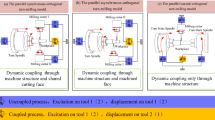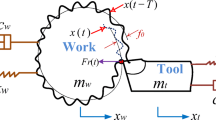Abstract
Parallel turning has the potential in enhancing the machining productivity and consequently reducing total production costs. However, due to the complex interaction of tools and workpieces, the stability of the process against chatter vibration is often decreased; hence, a successful chatter avoidance/suppression must be achieved. Recently, our research group suppressed the chatter in the shred-surface parallel turning by oscillating two tools in the circumferential direction of a flexible workpiece while keeping the equal pitch. However, there are insufficient discussion and experimental verification surrounding the optimal design for the tool swing motion (TSM). This paper presents a design methodology for the tool swing parallel turning based on the analogy with the spindle speed variation (SSV) techniques. A series of experiments were conducted while varying TSM design parameters to support the proposed design method. In-depth discussions regarding the experimental results were also carried out. The results of this study provide adequate information for properly tuning the TSM process for effective chatter suppression in practical applications.










Similar content being viewed by others
Abbreviations
- a t :
-
Acceleration of stage (m/s2)
- GLPF(s):
-
Low-pass filter (-)
- fc, ωc :
-
Chatter frequency (Hz) (ωc = 2πfc (rad/s))
- F cut :
-
Cutting force (N)
- Ffric, Tfric :
-
Friction force and torque (N, Nm)
- F grav :
-
Gravity force (N)
- fsw, ωsw :
-
Tool swing frequency (Hz), (ωsw = 2πfsw (rad/s))
- \( {I}_a^{\mathrm{ref}} \) :
-
Motor current reference (A)
- J r :
-
Total inertia of motor, coupling, and ball screw (kgm2)
- k :
-
Chatter lobe number (-)
- K t :
-
Torque coefficient (Nm/A)
- M t :
-
Movable mass (kg)
- N :
-
Number of teeth/cutters (-)
- R :
-
Transform coefficient for rotational to translational motion (mm/rad)
- RVA :
-
Relative amplitude of spindle speed variation against the mean (nominal) spindle speed (-)
- RVA opt :
-
Optimal value of RVA (-)
- RVF :
-
Relative frequency of spindle speed variation against the mean (nominal) spindle speed (-)
- RVF lim :
-
Lower limit value of RVF (-)
- S :
-
Spindle speed (min-1)
- S rel :
-
Relative spindle speed in TSM process (min-1)
- t :
-
Process time (s)
- α r :
-
Angular acceleration (rad/s2)
- ε :
-
Chatter phase shift (rad)
- θ :
-
Tool swing angle in TSM process (rad)
- θ 0 :
-
Offset angle in TSM process (rad)
- θ sw :
-
Amplitude of swing angle in TSM process (rad)
- ρ :
-
Amplitude ratio of the expected and the real delay term representing the efficiency of TSM process (-)
- τ :
-
Real delay in TSM process (s)
- \( \overset{\sim }{\tau } \) :
-
Expected delay in TSM process (s)
- \( \left(\hat{\mkern6mu}\right) \) :
-
Estimated value
- ()n :
-
Nominal value
References
Budak E, Ozturk E (2011) Dynamics and stability of parallel turning operations. CIRP Ann Manuf Technol 60(1):383–386. https://doi.org/10.1016/j.cirp.2011.03.028
Azvar M, Budak E (2017) Multi-dimensional chatter stability for enhanced productivity in different parallel turning strategies. Int J Mach Tools Manuf 123:116–128. https://doi.org/10.1016/j.ijmachtools.2017.08.005
Ozturk E, Comak A, Budak E (2016) Tuning of tool dynamics for increased stability of parallel (simultaneous) turning processes. J Sound Vib 360(6):17–30. https://doi.org/10.1016/j.jsv.2015.09.009
Reith MJ, Bachrathy D, Stepan G (2016) Optimal Detuning of a parallel turning system—theory and experiments. J Dyn Syst Meas Control 139(1):014503. https://doi.org/10.1115/1.4034497
Brecher C, Trofimov Y, Bäumler S (2011) Holistic modelling of process machine interactions in parallel milling. CIRP Ann Manuf Technol 60(1):387–390. https://doi.org/10.1016/j.cirp.2011.03.025
Sakata S, Kadota T, Yamada Y, Nakanishi K, Yoshioka H, Suzuki N, Kakinuma Y (2018) Chatter avoidance in parallel turning with unequal pitch angle using observer-based cutting force estimation. J Manuf Sci Eng 140(4):044501. https://doi.org/10.1115/1.4039111
Yamato S, Yamada Y, Nakanishi K, Suzuki N, Yoshioka H, Kakinuma Y (2018) Integrated in-process chatter monitoring and automatic suppression with adaptive pitch control in parallel turning. Adv Manuf 6(3):291–300. https://doi.org/10.1007/s40436-018-0222-0
Yamato S, Okuma T, Nakanishi K, Tachibana J, Suzuki N, Kakinuma Y (2019) Chatter suppression in parallel turning assisted with tool swing motion provided by feed system. Int J Autom Technol 13(1):80–91. https://doi.org/10.20965/ijat.2019.p0080
Al-Regib E, Ni J, Lee SH (2003) Programming spindle speed variation for machine tool chatter suppression. Int J Mach Tools Manuf 43(12):1229–1240. https://doi.org/10.1016/S0890-6955(03)00126-3
Otto A, Radons G (2013) Application of spindle speed variation for chatter suppression in turning. CIRP J Manuf Sci Technol 6(2):102–109. https://doi.org/10.1016/j.cirpj.2013.02.002
Urbikain G, Olvera D, de Lacalle LNL, Elías-Zúñiga A (2016) Spindle speed variation technique in turning operations: modeling and real implementation. J Sound Vib 383(24):384–396. https://doi.org/10.1016/j.jsv.2016.07.033
Hecker RL, Flores GM, Xie Q, Haran R (2008) Servocontrol of machine-tools: a review. Lat Am Appl Res 38:85–94
Altintas Y, Verl A, Brecher C, Uriarte L, Pritschow G (2011) Machine tool feed drives. CIRP Ann Manuf Technol 60(2):779–796. https://doi.org/10.1016/j.cirp.2011.05.010
Yamada Y, Kakinuma Y (2016) Sensorless cutting force estimation for full-closed controlled ball-screw-driven stage. Int J Adv Manuf Technol 87:3337–3348. https://doi.org/10.1007/s00170-016-8710-5
Yamada Y, Kadota T, Sakata S, Tachibana J, Nakanishi K, Sawada M, Kakinuma Y (2017) Integrated chatter monitoring based on sensorless cutting force/torque estimation in parallel turning. Int J Autom Technol 11(2):215–225. https://doi.org/10.20965/ijat.2017.p0215
Munoa J, Beudaert X, Dombovari Z, Altintas Y, Budak E, Brecher C, Stepan G (2016) Chatter suppression techniques in metal cutting. CIRP Ann Manuf Technol 65(2):785–808. https://doi.org/10.1016/j.cirp.2016.06.004
Insperger T, Stepan G (2004) Stability analysis of turning with periodic spindle speed modulation via semidiscretization. J Vib Control 10(12):1835–1855. https://doi.org/10.1177/1077546304044891
Zatarain M, Bediaga I, Muñoa J, Lizarralde R (2008) Stability of milling processes with continuous spindle speed variation: Analysis in the frequency and time domains, and experimental correlation. CIRP Ann Manuf Technol 57(1):379–384. https://doi.org/10.1016/j.cirp.2008.03.067
Jemielniak K, Widota A (1984) Suppression of self-excited vibration by the spindle speed variation method. Int J Mach Tool Des Res 24(3):207–214
Jayaram S, Kapoor SG, DeVor RE (2000) Analytical stability analysis of variable spindle speed machining. J Manuf Sci Eng 122(3):391–397. https://doi.org/10.1016/0020-7357(84)90005-2
Tunç LT, Budak E (2012) Effect of cutting conditions and tool geometry on process damping in machining. Int J Mach Tools Manuf 57:10–19. https://doi.org/10.1016/j.ijmachtools.2012.01.009
Ahmadi K, Ismail F (2011) Analytical stability lobes including nonlinear process damping effect on machining chatter. Int J Mach Tools Manuf 51(4):296–308. https://doi.org/10.1016/j.ijmachtools.2010.12.008
Liu CR, Liu TM (1985) Automated chatter suppression by tool geometry control. J Eng Ind 107(2):95–98. https://doi.org/10.1115/1.3185989
Sellmeier V, Denkena B (2012) High speed process damping in milling. CIRP J Manuf Sci Technol 5(1):8–19. https://doi.org/10.1016/j.cirpj.2011.12.001
Tarng YS, Young HT, Lee BY (1994) An analytical model of chatter vibration in metal cutting. Int J Mach Tools Manuf 34(2):183–197. https://doi.org/10.1016/0890-6955(94)90100-7
Altintas Y, Weck M (2004) Chatter stability of metal cutting and grinding. CIRP Ann Manuf Technol 53(2):619–642. https://doi.org/10.1016/S0007-8506(07)60032-8
Radulescu R, Kapoor SG, DeVor RE (1997) An investigation of variable spindle speed face milling for tool-work structures with complex dynamics, part 2: Physical explanation. J Manuf Sci Eng Trans ASME 119(3):273–280. https://doi.org/10.1115/1.2831104
Albertelli P, Mussi V, Monno M (2014) The analysis of tool life and wear mechanisms in spindle speed variation machining. Int J Adv Manuf Technol 72:1051–1061. https://doi.org/10.1007/s00170-014-5736-4
Suzuki N, Takahashi W, Igeta H, Nakanomiya T (2020) Flank face texture design to suppress chatter vibration in cutting. CIRP Ann 69(1):93–96. https://doi.org/10.1016/j.cirp.2020.04.037
Kayhan M, Budak E (2009) An experimental investigation of chatter effects on tool life. Proc Inst Mech Eng B J Eng Manuf 223(11):1455–1463. https://doi.org/10.1243/09544054JEM1506
Merino R, Bediaga I, Iglesias A, Munoa J (2019) Hybrid edge-cloud-based smart system for chatter suppression in train wheel repair. Appl Sci 9(20):4283. https://doi.org/10.3390/app9204283
Acknowledgments
The authors thank Mr. Okuma and OMRON Corporation for their support and assistance for this research.
Funding
A part of this study was supported by SIP Innovative Design and Production Technology Project commissioned by the New Energy and Industrial Technology Development Organization (NEDO) and JSPS Grant-in-Aid for JSPS Fellows Grant Numbers JP19J13204.
Author information
Authors and Affiliations
Corresponding author
Additional information
Publisher’s note
Springer Nature remains neutral with regard to jurisdictional claims in published maps and institutional affiliations.
Appendix
Appendix
In the TSM process, the process time delay is a time function. In the tool swing parallel turning, as two tools oscillate according to Eq. (5) while keeping the equal pitch, the following equation should hold:
The delay satisfying Eq. (10) can be calculated by numerical calculations such as the Newton-Raphson method, once the cutting conditions and time-varying profile of TSM are determined.
On the other hand, the expected time-varying delay in the TSM process, straightforwardly derived from Eq. (6), is as follows:
As a result, the amplitude ratio representing efficiency of TSM process can be defined as follows:
Rights and permissions
About this article
Cite this article
Yamato, S., Nakanishi, K., Suzuki, N. et al. Experimental verification of design methodology for chatter suppression in tool swing–assisted parallel turning. Int J Adv Manuf Technol 110, 1759–1771 (2020). https://doi.org/10.1007/s00170-020-05951-1
Received:
Accepted:
Published:
Issue Date:
DOI: https://doi.org/10.1007/s00170-020-05951-1




